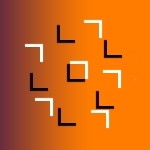
ISSN 2364-3641
Publications:
direct access:
vpl-reports.de
Open Access
| home | evaluation | archive | vpl-goettingen.de | impressum |
|
VPL-reports, 2, 1-97
Salience in vision is achieved from various stimulus properties; luminance differences are the most frequent ones in daily life. This study investigated properties of luminance-defined target salience and explored the rules of how salience changes when the target, its surrounding background, or distractors nearby change their luminance. Two experimental sections of the paper present data when subjects matched targets in different surroundings (luminance range 5.5-68 cd/m2) for equal salience. In a third, computational section these data are compared with predictions from various algorithms. Some observations can be generalized. (1) Salience computations differ between dark and bright targets, and between targets in different rankings to distractors. For dark maximum targets (the target is the darkest item in the scene), salience computation followed the constant-addition principle, that is, targets appeared equally salient when their luminance difference to distractors was the same; the background luminance was (almost) not important. For bright targets, salience computation often followed the salmin algorithm, a modification of the constant-ratio principle (Weber contrast); background luminance settings were important. But deviations from these rules were also seen. Particularly good performance with bright targets was sometimes obtained with the averages of two algorithms. (2) In cross-polarity salience matches (bright targets compared with dark targets) predictions of equal salience matches were strongly improved when luminance scales were power-transformed. This was not the case for same-polarity matches (e.g., dark targets matched against dark targets). (3) Different aspects of salience must be distinguished, such as discrimination salience (which distinguishes the target from distractors) and item salience (which distinguishes targets from background). In certain stimulus configurations, item salience can be smaller than discrimination salience and may then affect the perceived salience of a target. (4) In computational analysis, quite a few algorithms could explain certain experimental data and failed with others. There was no single "super" algorithm that could reliably predict all salience matches of different target combinations. Major findings are demonstrated and the role of salience variations with retinal eccentricity is discussed.
|
Download pdf ppt of figures Comments: |
©